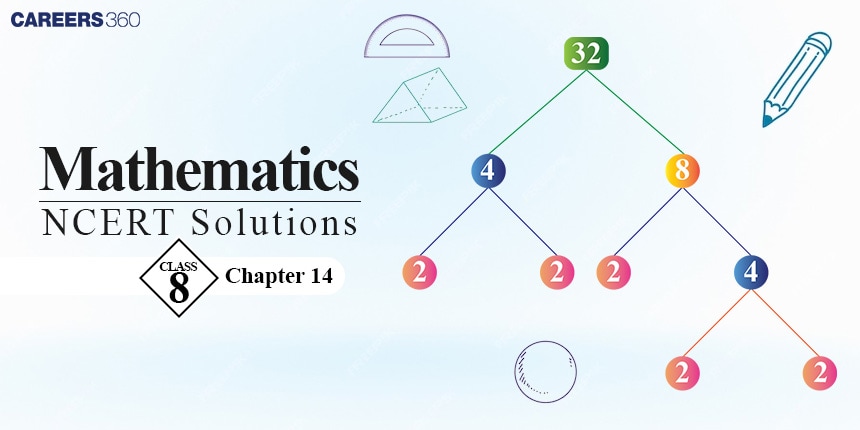Aakash Repeater Courses
ApplyTake Aakash iACST and get instant scholarship on coaching programs.
Have you ever imagined how nice it would have been if breaking down complex algebraic expressions could be as easy as breaking a number into its prime factors? That’s exactly what we will learn in Chapter 12, Factorisation. It is one of the important topics of the NCERT Class 8 Maths. With the help of factorisation, we can break down large and complex algebraic expressions into multiple small parts, which are known as factors. For example, 6 = 2 × 3, so we can say that 2 and 3 are the factors of the number 6. This article, about NCERT Solutions for Class 8 Maths, will provide comprehensive step-by-step solutions to all the exercise problems in the chapter.

These NCERT Solutions are highly reliable as they are developed by the subject matter experts of Careers360. These solutions are of great help for the exam preparation as the students can practice the exercise problems and check the answers to evaluate their performance, and can focus on their weaker areas. Students can refer to the NCERT Solutions for Class 8 to access the subject-wise solutions for the Class.
Students who wish to access the NCERT solutions for Class 8 Maths Chapter 12, Factorization, can click on the link below to download the entire solutions in PDF format for free.
| Class 8 Maths Chapter 12 Question Answer: Exercise: 12.1.1 Total Questions: 3 Page number: 147 |
Question:(i) Factorise:
Answer:
We have
So, we have
Therefore,
| Class 8 Maths Chapter 12 Question Answer: Exercise: 12.1.2 Total Questions: 3 Page number: 148-149 |
Question:1(i) Find the common factors of the given terms.
Answer:
We have
So, the common factors between the two are
Question:1(ii) Find the common factors of the given terms
Answer:
We have,
Therefore, the common factor between these two is 2y
Question:1(iii) Find the common factors of the given terms
Answer:
We have,
Therefore, the common factor is
Question:1(iv) Find the common factors of the given terms.
Answer:
We have,
Therefore, the common factor between these three is 1
Question:1(v) Find the common factors of the given terms
Answer:
We have,
Therefore, the common factor is
Question:1(vi) Find the common factors of the given terms
Answer:
We have,
Therefore, the common factor is
Question:1(vii) Find the common factors of the given terms
Answer:
We have,
Therefore, the common factors between these three is
Question:1(viii) Find the common factors of the given terms
Answer:
We have,
Therefore, the common factors between these three are
Question:2(ix) Factorise the following expressions
Answer:
We have,
Therefore, on factorization we get,
Question:2(x) Factorise the following expressions
Answer:
We have,
Therefore, on factorization we get,
| Class 8 Maths Chapter 12 Question Answer: Exercise: 12.2 Total Questions: 5 Page number: 151-152 |
Question:1(i) Factorise the following expressions
Answer:
We have,
Therefore,
Question:1(vii) Factorise the following expressions
Answer:
We have,
=
=
Question:1(viii) Factorise the following expressions
Answer:
We have,
=
Question:2(i) Factorise :
Question:3(vi) Factorise the following expressions
Answer:
We have,
Take ( y+z) common from this
Therefore,
| Class 8 Maths Chapter 12 Question Answer: Exercise: 12.3.1 Total Questions: 2 Page number: 153 |
Question:(i) Divide
Answer:
We have,
| Class 8 Maths Chapter 12 Question Answer: Exercise: 12.3 Total Questions: 5 Page number: 155 |
Question:1(i) Carry out the following divisions
Answer:
This is done using factorization.
Question:1(ii) Carry out the following divisions
Answer:
We have,
Therefore,
Question:1(iii) Carry out the following divisions
Answer:
We have,
Therefore,
Question:5(iv) Factorise the expression and divide then as directed
Answer:
We first simplify our numerator
So,
Add and subtract 64
Now,
Question:5(vi) Factorise the expression and divide then as directed
Answer:
We first simplify our numerator,
Using
Now,
Question:5(vii) Factorise the expression and divide then as directed
Answer:
We first simplify our numerator,
=
=
Now,
The topics discussed in the NCERT Solutions for class 8, chapter 12, Factorization, are:
Factorization: Factorization is the process of expressing an algebraic equation as a product of its components. These components can be numbers, variables, or algebraic expressions.
Irreducible Factor: An irreducible factor is a component that cannot be further factored into a product of factors.
The common factor approach involves three steps:
Write each term of the statement as a product of irreducible elements.
Look for and separate similar components.
Combine the remaining elements in each term using the distributive law.
The regrouping approach involves grouping terms in a way that brings out a common factor across the groups.
Common Factor Identity: Certain factorable expressions take the form of:
a2 + 2ab + b2 = (a + b)2
a2 - 2ab + b2 = (a - b)2
a2 - b2 = (a + b)(a - b)
x2 + (a + b)x + ab = (x + a)(x + b)
Dividing a Polynomial by a Monomial: When dividing a polynomial by a monomial, you can divide each term of the polynomial by the monomial or use the common factor technique.
Division of Algebraic Expressions: In the division of algebraic expressions, you factor both the dividend and the divisor, then cancel common factors.
Division Formula: Dividend = Divisor × Quotient or Dividend = Divisor × Quotient + Remainder.
Given below are all the chapter-wise NCERT class 8 maths solutions given in one place for ease of access:
The NCERT Subject-wise Solutions for Class 8 is an essential study resource that helps students get trustworthy solutions for each subject to make the exam preparation easier. Students can refer to those solutions using the links below.
Students can also refer to the NCERT Books and the NCERT Syllabus using the links below:

Take Aakash iACST and get instant scholarship on coaching programs.

This ebook serves as a valuable study guide for NEET 2025 exam.

This e-book offers NEET PYQ and serves as an indispensable NEET study material.

As per latest syllabus. Physics formulas, equations, & laws of class 11 & 12th chapters

As per latest syllabus. Chemistry formulas, equations, & laws of class 11 & 12th chapters
As per latest 2024 syllabus. Study 40% syllabus and score upto 100% marks in JEE